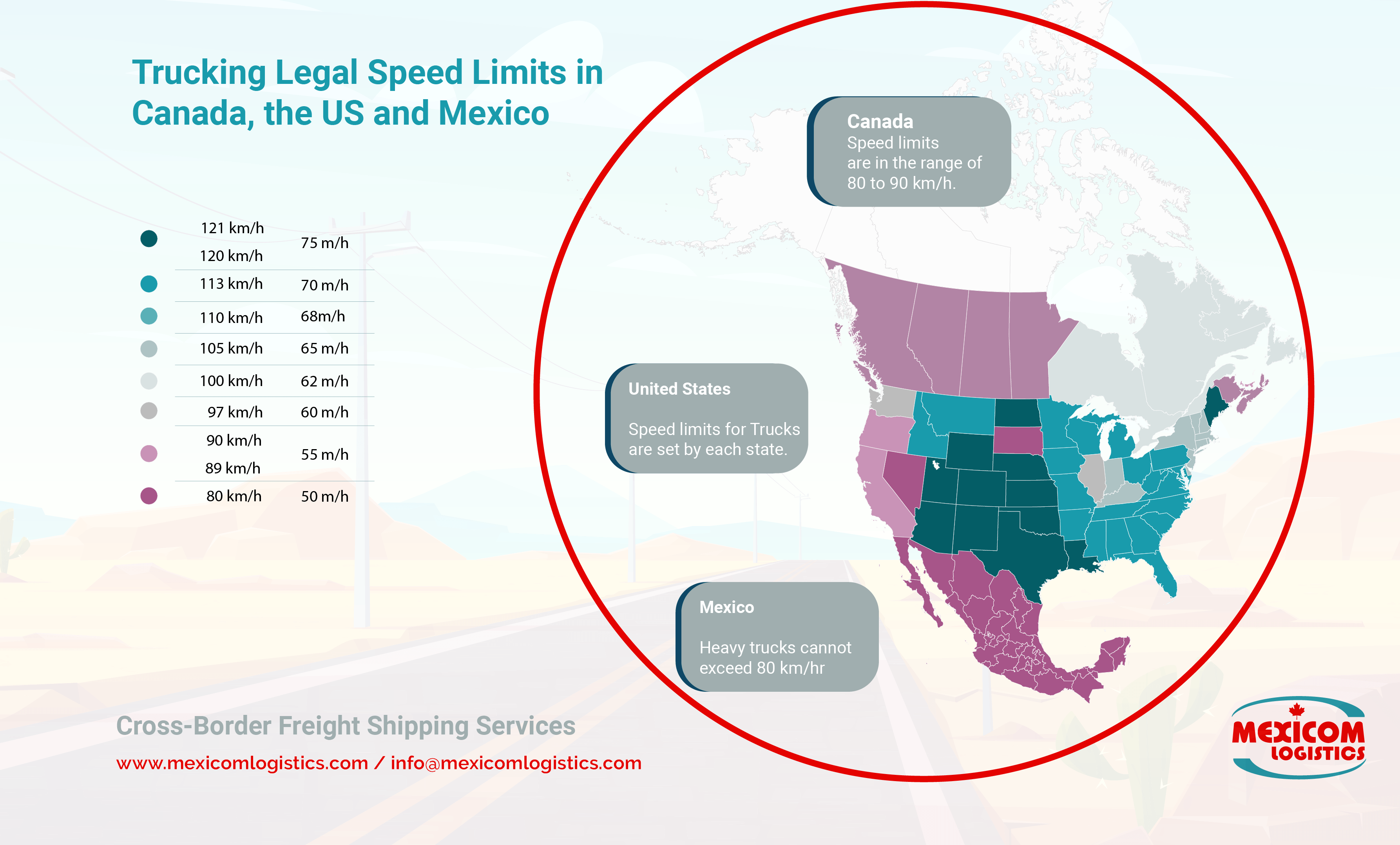[Infographic ] An update on speed limits for trucking in Mexico, the US and Canada (mph and km/h)
The publication of the New Mobility and Road Safety Law in Mexico, as well as the revival of discussions on the implementation of speed limiters for heavy trucks in the United States, make it pertinent to review the current speed limits applicable for trucking in Mexico, the United States, and Canada.
In this article, we present an infographic showing the most current speed limits set for heavy trucks transporting commercial goods through the three North American countries.
Likewise, we review the subject of speed limiters, initiatives, and reactions in the industry.

Speed limits for heavy trucks in Mexico
In Mexico, heavy trucks cannot exceed 80 km/hr (50mph) on federal highways.
There is a New Mobility and Road Safety Law that enforces new speed limits throughout the Mexican territory.
On May 18, 2022, the new General Law of Mobility and Road Safety entered into force, which contemplates the new speed limits that will are now applied throughout the Mexican territory.
What is new about the New Mobility and Road Safety Law in Mexico?
The law seeks to standardize speed limits on all roads in Mexico. Before, each State had its own guidelines regarding speed limits on highways.
The provincial objective of the law is to reduce the number of road accidents.
Speed limits for heavy trucks in the U.S.
In the U.S., speed limits for Trucks are set by each state.
| State | Rural interstates | Urban interstates | ||
| (mph) | (km/h) | (mph) | (km/h) | |
| Alabama | 70 | 113 | 65 | 105 |
| Alaska | 65 | 105 | 55 | 89 |
| Arizona | 75 | 121 | 65 | 105 |
| Arkansas | 70 | 113 | 65 | 105 |
| California | 55 | 89 | 55 | 89 |
| Colorado | 75 | 121 | 65 | 105 |
| Connecticut | 65 | 105 | 55 | 89 |
| Delaware | 65 | 105 | 55 | 89 |
| Florida | 70 | 113 | 65 | 105 |
| Georgia | 70 | 113 | 70 | 113 |
| Idaho | 70 | 113 | 65 | 105 |
| Illinois | 60 | 97 | 55 | 89 |
| Indiana | 65 | 105 | 55 | 89 |
| Iowa | 70 | 113 | 55 | 89 |
| Kansas | 75 | 121 | 75 | 121 |
| Kentucky | 65 | 105 | 65 | 105 |
| Louisiana | 75 | 121 | 70 | 113 |
| Maine | 75 | 121 | 75 | 121 |
| Maryland | 70 | 113 | 70 | 113 |
| Massachusetts | 65 | 105 | 65 | 105 |
| Michigan | 65 | 105 | 70 | 113 |
| Minnesota | 70 | 113 | 65 | 105 |
| Mississippi | 70 | 113 | 70 | 113 |
| Missouri | 70 | 113 | 60 | 97 |
| Montana | 70 | 113 | 65 | 105 |
| Nebraska | 75 | 121 | 70 | 113 |
| Nevada | 80 | 129 | 65 | 105 |
| New Hampshire | 65 | 105 | 65 | 105 |
| New Jersey | 65 | 105 | 55 | 89 |
| New Mexico | 75 | 121 | 75 | 121 |
| New York | 65 | 105 | 65 | 105 |
| North Carolina | 70 | 113 | 70 | 113 |
| North Dakota | 75 | 121 | 75 | 121 |
| Ohio | 70 | 113 | 65 | 105 |
| Oklahoma | 75 | 121 | 70 | 113 |
| Oregon | 55 | 89 | 55 | 89 |
| Pennsylvania | 70 | 113 | 70 | 113 |
| Rhode Island | 65 | 105 | 55 | 89 |
| South Carolina | 70 | 113 | 70 | 113 |
| South Dakota | 80 | 129 | 80 | 129 |
| Tennessee | 70 | 113 | 70 | 113 |
| Texas | 75 | 121 | 75 | 121 |
| Utah | 75 | 121 | 65 | 105 |
| Vermont | 65 | 105 | 55 | 89 |
| Virginia | 70 | 113 | 70 | 113 |
| Washington | 60 | 97 | 60 | 97 |
| West Virginia | 70 | 113 | 55 | 89 |
| Wisconsin | 70 | 113 | 70 | 113 |
| Wyoming | 75 | 121 | 75 | 121 |
Speed limits for heavy trucks in Canada
In Canada, typical speed limits on two-lane undivided rural highways are in the range of 80 to 90 km/h but highways can have posted speed limits of 100 km/h
Speed Limiter Usage – A hot topic in North America
Speed Limiter Usage in the U.S.
- The U.S. FMCSA plans to move forward with the speed limiter rulemaking process
On April, the U.S. Federal Motor Carrier Safety Administration filed a Speed Limiters Notice of Intent. The FMCSA is proposing that commercial motor vehicles in interstate commerce with gross weights of 26,001 pounds or more be equipped with electronic engine control units (ECUs) to limit them.
“The forthcoming rulemaking, if adopted, would impose speed limitations on certain CMVs that operate in interstate commerce. The NOI is not proposing a maximum speed nor does it propose regulatory text or estimates of the costs or safety benefits. FMCSA is requesting public comments on the programming or adjustment of ECUs that could be made to impose speed limits on CMVs to support the preparation of a supplemental notice of proposed rulemaking.”
There are opposite reactions in the trucking industry in the U.S. :
In favor:
“We intend to thoroughly review FMCSA’s proposal, and we look forward to working with the agency to shape a final rule that is consistent with our policy supporting the use of speed limiters in conjunction with numerous other safety technologies,” – Said Chris Spear, President and CEO of the American Trucking Associations
Opposed the initiative:
“Limiting trucks to speeds below the flow of traffic increases interactions between vehicles which can lead to more crashes.” – Commented Todd Spencer, President of the Owner-Operator Independent Drivers Association
Speed Limiter Usage in Canada
Ontario and Quebec mandate speed limiter technology set at 105 km/h on all trucks operating in those provinces.
This requirement applies to all trucks and equipment transport vehicles assembled after December 31, 1994 (motor vehicles), with a gross vehicle weight rating of 11 794 kg (26 000 lbs) or more, and equipped with a standard speed limiter.
The speed limit on Quebec freeways is 100km/h, However, the speed limiter is requested to be set at 105km/h to be to consistent with other North American jurisdictions that have speed limits slightly higher than 100 km/h.
Some facts about Speed Limiter usage:
- Speed limiters limit the maximum attainable road speed and have been standard equipment on most heavy trucks built since mid-1990.
- The vast majority of CMVs in operation today are equipped with ECUs.
- It is estimated that at least 60% of heavy truck fleets in North America use speed limiters.
Speed limiters and savings in Diesel
- A Canadian study that assessed the potential national diesel fuel savings and corresponding greenhouse gas (GHG) reductions from a national speed limiter mandate found that
A national mandate would potentially result in fuel savings of 228.6 million litres of on-road diesel. This represents 1.4% of the total on-road diesel consumed in 2006. Annual GHG savings are estimated at 0.64 megatonnes. Ontario and Quebec combined would account for 64% of the estimated national savings.Of the estimated annual fuel savings of 228.6 million litres, three provinces – Ontario, Quebec, Alberta – would account for 83% of the savings.
Sources:
https://www.diputados.gob.mx/LeyesBiblio/pdf/LGMSV.pdf
https://www.iihs.org/topics/speed/speed-limit-laws
https://tc.canada.ca/en/summary-report-assessment-heavy-truck-speed-limiter-requirement-canada
https://le.utah.gov/xcode/Title41/Chapter6a/41-6a-S602.html
https://gomotive.com/blog/us-speed-limits-for-drivers/
https://www.transports.gouv.qc.ca/en/camionnage/Pages/limiteurs-de-vitesse.aspx
https://www.diputados.gob.mx/LeyesBiblio/pdf/LGMSV.pdf
https://www.ooida.com/2022/speed-limiters-on-trucks-would-increase-highway-crashes/



![[Infographic ] An update on speed limits for trucking in Mexico, the US and Canada (mph and km/h) [Infographic ] An update on speed limits for trucking in Mexico, the US and Canada (mph and km/h)](https://mexicomlogistics.com/wp-content/uploads/bfi_thumb/dummy-transparent-qmy27ecmsnaigc9wfav3hivea8amvwflcy7ico73qw.png)






